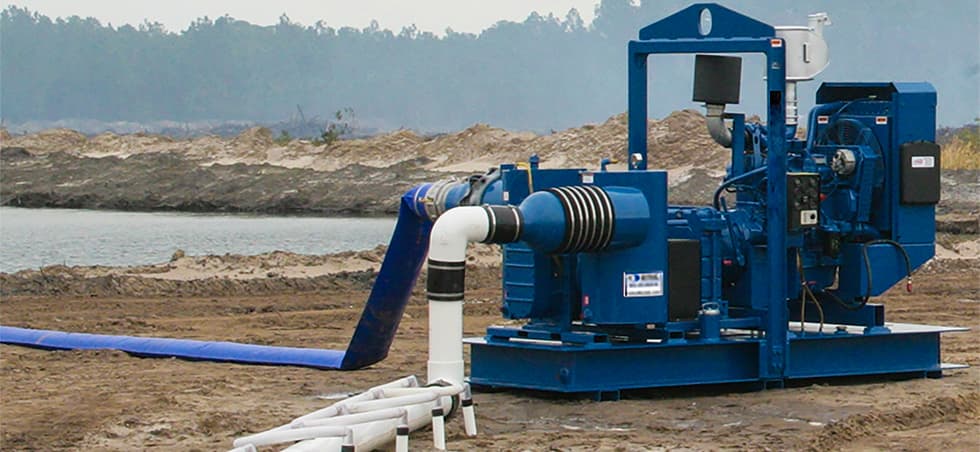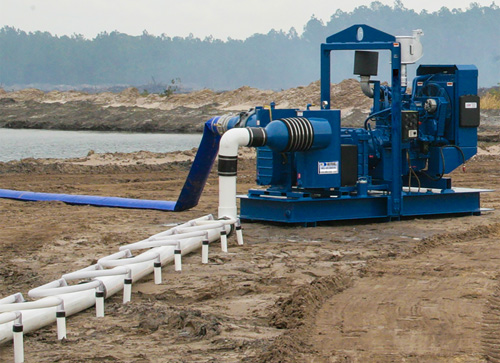
As land becomes more expensive, leveraging the real estate below the earth’s surface for parking garages, new utilities and even meeting rooms has become a reality. And, as any experienced contractor knows, excavating in these spaces often turns up something other than soil—namely, groundwater.
All construction foundations and structures below the water table will require some type of dewatering. Contractors or engineering firms often assume the dewatering system used on previous projects (usually a simple wellpoint system) will work on all projects. But looks can be deceiving. Companies may underestimate the amount of water they will encounter or fail to realize where it might come from.
The Risks of Inadequate Dewatering
When dewatering is not considered or the wrong dewatering method is chosen, the results can be costly in terms of time, money, reputation and safety.
If the dewatering system proves inadequate, work may halt while additional pumps are installed, and every day work does not get done, users lose money and fall behind schedule. The costs can mount quickly. To meet the project deadline and avoid penalties, companies may need to rent additional excavators, loaders and dump trucks. There may be extra fuel costs at a time when fuel prices are skyrocketing, and companies may need to hire additional crews, which on large projects can run $25,000 a day or more.
Water from the ground and surface due to rain events can damage construction equipment and reduce productivity. In the worst-case scenario, water could end up destroying work that has been performed. Wet or muddy jobsites also pose safety issues for crews, especially when water compromises the stability of slopes.

Planning for All Possibilities
Choosing the right dewatering method requires considering the current conditions as well as possible future conditions. The soil types, excavation depth and buildings and infrastructure surrounding the site can influence a project. Taking a detailed soil boring to understand the soil components and the strata (including where the permeable layers are and the depth and formation of each layer) and performing a pump test are critical to determining the best method.
It is also important to anticipate weather events. For example, a contractor was putting in a sewer line and an engineer specified a single wellpoint system for dewatering but it was not robust enough to control flooding when it rained. So, an equipment rental company created a backup dewatering system by installing wellpoints on both sides of the excavation and additional sump pumps to handle the surface water. That dried out the area enough for the contractor to work but subcontractors had to work around several additional 6-inch pumps. Had the weather contingencies been anticipated upfront, the problem might have been avoided.
For waterfront projects, factoring in the tidal system and water fluctuation is essential. When a contractor in Mississippi was working on a drop-in structure, its engineers also recommended a wellpoint system. Then the Mississippi River rose, and there was so much water the structure broke. The contractor had to tear up the bottom of the structure, remove the concrete they had poured and redo all the work, resulting in additional labor and cost and a three-month delay.
Questions to Ask
Other considerations factor into creating an effective dewatering plan:
- Does the site show any signs of soil erosion or instability?
- How far below the surface is the water table?
- Should the water level be lowered in advance of excavation? (This may be necessary if the subgrade is a uniform, fine sand stratum.)
- Is the subgrade under artesian pressure that could cause uplift or soften the subgrade soil under a nearby structure or pipeline?
- Are there nearby buildings or structures that could be impacted and how will they be protected?
- Will standby equipment be available
- in case continuous dewatering pumping is needed?
- What impact will rewatering have on the site and the surroundings when the project is over?
The plan should also include details about closing and removing the dewatering systems and following state and local procedures to avoid contaminating groundwater.
Beyond Wellpoint Systems
Wellpoint dewatering systems are often suited for dewatering when digging shallow foundations and performing utility work and trench work. They are not the solution for every dewatering project, however. Contractors should ask the engineer whether other options may be more appropriate for the site. For example, if the excavation will go below 26 feet or if there is a need to pump out large quantities of groundwater, a deep well system might be best. A sock dewatering system is good for shallow excavations (5 to 15 feet), especially when needing to limit ground obstructions. Open pumping systems can remove large quantities of water quickly.
For all dewatering approaches, users will need an installed header system with a flow meter to measure the flow rate. In most cases, a filtration system will be necessary to clear the discharge of any siltation before returning it to the environment. The engineer must choose necessary groundwater filtration systems to avoid penalties for environmental noncompliance.
Avoiding Risks
An effective dewatering plan and the right dewatering equipment decrease the risk of unnecessary delays while increasing jobsite safety. Choosing and designing a dewatering method is part art and part science. It is based on investigation of the area, including the soil and hydrology. It is also based on experience. A company that has experience with various dewatering methods and has encountered a variety of challenges that can arise is best positioned to recommend and design the right system for the project.
The initial investment in a company with dewatering expertise pays off when the site stays dry enough for work to continue despite groundwater situations or ordinary weather conditions. Majid Tavakoli is the director of dewatering technology for United Rentals. Tavakoli earned a Bachelor of Science in mechanical engineering from West Virginia Tech and has 39 years of construction dewatering experience. Tavakoli previously served as vice president of application for Thompson Pump & Manufacturing for 36 years. For more information, visit unitedrentals.com.

